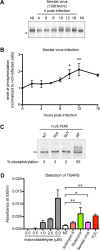Modulation of Innate Immune Signalling by Lipid-Mediated MAVS Transmembrane Domain Oligomerization
- PMID: 26317833
- PMCID: PMC4552940
- DOI: 10.1371/journal.pone.0136883
Modulation of Innate Immune Signalling by Lipid-Mediated MAVS Transmembrane Domain Oligomerization
Abstract
RIG-I-like receptors detect viral RNA in infected cells and promote oligomerization of the outer mitochondrial membrane protein MAVS to induce innate immunity to viral infection through type I interferon production. Mitochondrial reactive oxygen species (mROS) have been shown to enhance anti-viral MAVS signalling, but the mechanisms have remained obscure. Using a biochemical oligomerization-reporter fused to the transmembrane domain of MAVS, we found that mROS inducers promoted lipid-dependent MAVS transmembrane domain oligomerization in the plane of the outer mitochondrial membrane. These events were mirrored by Sendai virus infection, which similarly induced lipid peroxidation and promoted lipid-dependent MAVS transmembrane domain oligomerization. Our observations point to a role for mROS-induced changes in lipid bilayer properties in modulating antiviral innate signalling by favouring the oligomerization of MAVS transmembrane domain in the outer-mitochondrial membrane.
Conflict of interest statement
Figures





Similar articles
-
The mitochondrial antiviral protein MAVS associates with NLRP3 and regulates its inflammasome activity.J Immunol. 2013 Oct 15;191(8):4358-66. doi: 10.4049/jimmunol.1301170. Epub 2013 Sep 18. J Immunol. 2013. PMID: 24048902 Free PMC article.
-
Structural Insights into mitochondrial antiviral signaling protein (MAVS)-tumor necrosis factor receptor-associated factor 6 (TRAF6) signaling.J Biol Chem. 2015 Oct 30;290(44):26811-20. doi: 10.1074/jbc.M115.666578. Epub 2015 Sep 18. J Biol Chem. 2015. PMID: 26385923 Free PMC article.
-
Influenza M2 protein regulates MAVS-mediated signaling pathway through interacting with MAVS and increasing ROS production.Autophagy. 2019 Jul;15(7):1163-1181. doi: 10.1080/15548627.2019.1580089. Epub 2019 Feb 20. Autophagy. 2019. PMID: 30741586 Free PMC article.
-
Mechanisms of MAVS regulation at the mitochondrial membrane.J Mol Biol. 2013 Dec 13;425(24):5009-19. doi: 10.1016/j.jmb.2013.10.007. Epub 2013 Oct 9. J Mol Biol. 2013. PMID: 24120683 Free PMC article. Review.
-
Exploring the role of mitochondrial antiviral signaling protein in cardiac diseases.Front Immunol. 2025 Feb 18;16:1540774. doi: 10.3389/fimmu.2025.1540774. eCollection 2025. Front Immunol. 2025. PMID: 40040697 Free PMC article. Review.
Cited by
-
Mitochondrial Reactive Oxygen Species in TRIF-Dependent Toll-like Receptor 3 Signaling in Bronchial Epithelial Cells against Viral Infection.Int J Mol Sci. 2023 Dec 22;25(1):226. doi: 10.3390/ijms25010226. Int J Mol Sci. 2023. PMID: 38203397 Free PMC article.
-
Comprehensive characterization of the transcriptional landscape in Alzheimer's disease (AD) brains.Sci Adv. 2025 Jan 3;11(1):eadn1927. doi: 10.1126/sciadv.adn1927. Epub 2025 Jan 3. Sci Adv. 2025. PMID: 39752483 Free PMC article.
-
Mitochondria: An Organelle of Bacterial Origin Controlling Inflammation.Front Immunol. 2018 Apr 19;9:536. doi: 10.3389/fimmu.2018.00536. eCollection 2018. Front Immunol. 2018. PMID: 29725325 Free PMC article. Review.
-
Alzheimer's Disease Pathogenesis: Role of Autophagy and Mitophagy Focusing in Microglia.Int J Mol Sci. 2021 Mar 24;22(7):3330. doi: 10.3390/ijms22073330. Int J Mol Sci. 2021. PMID: 33805142 Free PMC article. Review.
-
Mitochondrial Hyperactivity and Reactive Oxygen Species Drive Innate Immunity to the Yellow Fever Virus-17D Live-Attenuated Vaccine.bioRxiv [Preprint]. 2024 Sep 15:2024.09.04.611167. doi: 10.1101/2024.09.04.611167. bioRxiv. 2024. Update in: PLoS Pathog. 2025 Apr 21;21(4):e1012561. doi: 10.1371/journal.ppat.1012561. PMID: 39282299 Free PMC article. Updated. Preprint.
References
Publication types
MeSH terms
Substances
Grants and funding
LinkOut - more resources
Full Text Sources
Other Literature Sources
Miscellaneous

